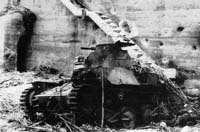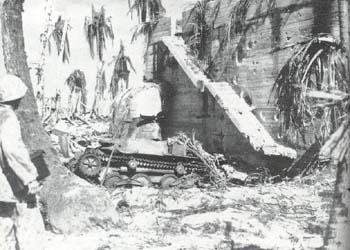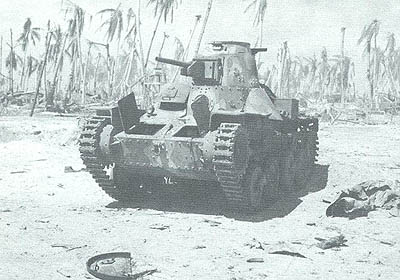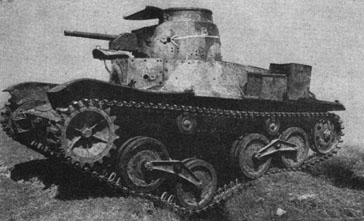Besides the numerous guns and emplacements on Betio, a number of Type 95 "Ha Go" tanks were available to the Rikusentai. They had a three man crew with one 7.7mm machine gun in the hull and a 37mm main gun with a second 7.7mm machine gun located in the turret. The WWII Japanese Army Website gives an excellent description of this type of tank. The two most important sources for the invasion of Tarawa disagree on the exact number of Japanese tanks on Betio. According to Stockman, fourteen Japanese tanks were stationed on Tarawa. His cites an intelligence study, "Jap Defenses of Betio Island, Part I, JICPOA" and information from 2nd Marine Division reports. Shaw, for some reason reports only seven tanks in the History of Marine Corps Operations in WWII.1 At least six of these Japanese light tanks are featured below.

During the battle some of these tanks roamed Betio while others were dug in as immobile pillboxes. The only tank battle on Tarawa happened somewhere around Red Beach 1. One of the new Marine M-4 Sherman tanks, named China Gal, was advancing across the beach when a type 95 suddenly appeared. China Gal's commander, Lt Edward Bale, fired his tank's 75mm gun at the Japanese light tank, destroying it. However, whoever this Japanese tanker was, he was fast. His incredible shot went right down the tube of China Gal. That 37mm round destroyed China Gal's main gun making it an armored machine gun for the rest of the battle.2
One of dug in Japanese tanks was knocked out by Sgt Roy W. Johnson. His squad and the entire right flank of his company was held up from the continuous fire of this tank. "Without regard for his own safety," reported Leatherneck in 1944, "Johnson fearlessly crawled through fire to the tank, climbed to the turret and then with great coolness opened the escape hatch and dropped a grenade into the tank. With keen presence of mind he slammed the hatch and sat on it until the grenade exploded, completely knocking out the tank out of action. Sgt. Johnson was later killed in action fearlessly leading his men."3

Note the hull penetrations on this tank.Of the few Japanese defenders to survive the battle one was a tanker. His name was Tadao Onuki and his story was published in Japan in 1970.4 His tank and two others were located near the concrete blockhouse headquarters early in the morning on the day the invasion. As the pre-invasion bombardment ended Onuki exited his tank to check for new orders with the other crews. The second tank was ready and waiting but the members of a third crew were seriously wounded due to a observation slit being left open. Without new orders Onuki decided to take his tank closer to the beach accoeding to the Japanese defense doctrine of destroying the enemy on the beach. However the second tank refused to leave their position at the blockhouse.
Onuki's tank refused to start, this was the beginning of his mechanical problems. The second tank gave a twenty yard push and finally Onuki's tank started. At the same time shells from the Ringgold firing in the lagoon began falling around them. Onuki reportedly thought that the destroyer noticed the cloud of black exhaust that came from the tank when the tank engine turned over. After seeking shelter behind the blockhouse the shelling soon shifted further away and Onuki headed west.
After driving about 800 yards Onuki took up a position north of the aircraft revetments at the base of the cove. Here he had a good field of fire toward the beach and out into the lagoon where the amtracs were heading for shore. Interestingly Onuki said he saw no evidence of other well camoflauged Japanese except for a "...tremendous curtain of fire against the lagoon." Onuki began firing the turret machine gun and the 37mm main gun at the approaching Marines, "There we broke our silence. Under roaring fires, enemy craft wrecked, American soldiers went down one after another, went falling into the sea."
A short time later Onuki noticed 1st Lt. Lou Largey's group of 8 Sherman tanks approaching Red Beach 3 along the pier. Of more concern to him was Ed Bale's two remaining tanks making their way around "the beak", the northwestern tip of Betio, on Red Beach 1. These tanks Colorado and China Gal would be a threat Onuki reports he was nervous at the appoarch of these two tanks so close to his position. However, a sailor soon pounded his rifle butt on the tank and shouted to give Onuki new orders to return to the blockhouse imediately. Back at the blockhouse Onuki was told by an officer that besides his tank only one other was still operational. The two tanks were to be "the admiral's eyes." They were to get in touch with outlying units since the communication system was destroyed.
After exiting the command post Onuki found no trace of his two man crew. Petty Officer Shiraishi, one of the members of the tank crew wounded that morning, and another sailor named Ota volunteer as his crew. Onuki and his scatch crew apparently headed west over the the main airstrip bumping up and down over shell craters. It is possible that they were attepmting to make contact with The Pocket. Mechanical problems began plauging the tank again. The engine cut out periodically possibly due to fuel sloshing around from the pockmarked ground. While Onuki struggled with the engine Ota spotted "a skirmish line of Marines" hurrying across the airstrip. Russ write that these were probably from Jordan's or Kyle's battalions.5 Ota fired a number of 37mm rounds and Shiraishi fired bursts from the hull machine gun. Onuki was frantically trying to start the engine and was terrified that the Marines would surround the sitting duck tank. Finally the engine came to life and they slowly began heading back to the blockhouse. The clutch had burnt out forcing them to .
At this point during the afternoon of D-Day, Alexander speculates that Admiral Shibaski was killed. The Admiral was attempting to transfer his headquarters from the impregnable blockhouse to a position on the south coast to make way for the ever increasing amount of wounded men seeking protection. Onuki writes,
"The situation of our battle was worse and worse for us. The headquarters for Rear Admiral Shibasaki and others had to move from the first command post to the second post, and our tank was ordered to cover thier move. Around that time our tank was hardly able to move because of shortage of fuel.
Two groups were formed to make the move to the south shore, one with Admiral Shibasaki and the other with his chief of staff. Onuki was assigned to the second group to make a diversion for the Admiral's group.
I was getting out of my tank. At that instance, one shell from an enemy ship came and exploded with a tremendous sound, and two of my friends who got out of the tank before me dissappeared, blown up by the shell. I could not find their remains.6
TO BE CONTINUED....

|

|
These two pictures show a disabled type 95 in front of the Japanese command post off Red Beach 3. Both pictures show the same tank from a slightly different angle. This particular tank could have been Onuki's according to Alexander.7

|

|
The left tank was located near the log revetments near the west end of the runway. The location of the tank on the right is either on the western part of Betio or inland from Red Beach 3.

This tank seems to have been abandoned somewhere on the edge of the airstrip.
A tri-color camoflage can clearly be seen on this tank.

A marine inspects a nearly intact Type 95. The three color camouflage scheme
is clearly visible.

Possibly another Type 95. Notice the left fender is bent unlike the other tanks shown on this page.


A type 95
abandoned on the beach amid wrecked LVTs. Presumably
this tank was driven to this location by US forces after the fighting had
ceased.

In the aftermath of battle this Marine gently gave water to a kitten under a Type 95 tank.
This Marine is Norm Hatch!
Notes 1. Stockman, p.85 Appendix I; Shaw, p.51
2. Clyde H. Metcalf , "This was Tarawa", Marine Corps Gazette, May 1944, p. 46.
3. Alexander, p.127; Hammel also records this event.
4. Tadao, Onuki, "The End of the Tarawa Garrison," in Masanori Ito, Sadatoshi Tomiaka, and Masazumi Inada, ed., Jitsuroku Taiheyo sense (3) (Real Accounts of the Pacific War), vol. III. Tokyo: Chuo Koron Sha, 1970. From Alexander, Bibliography p. 290.
5. Russ, Line of Departure, p. 108.
6 Alexander p. 148-9.
7. Ibid., p. 149.
Preserved examples of the Type 95 can still be found today.
Special thanks
to Taki, of the WWII Japanese
Army Website, for some of the pictures.
Thanks again Taki!
copyright 2000 T.O.T.W.
Created 20 February 20, 2000 - Updated 27 August
2003

Return to Index
Return to Weapons and Equipment
